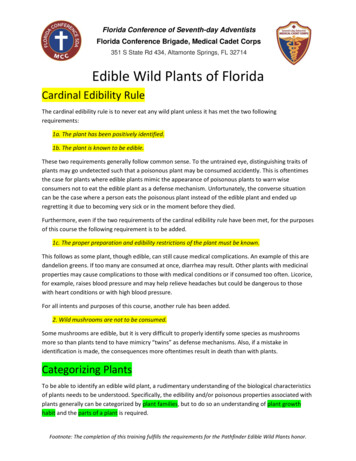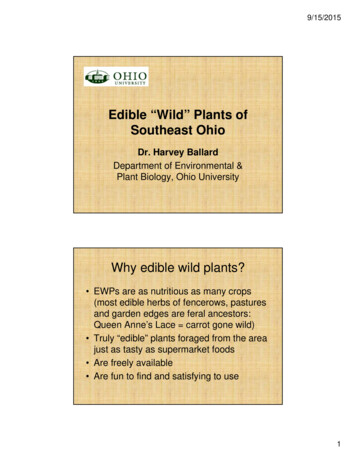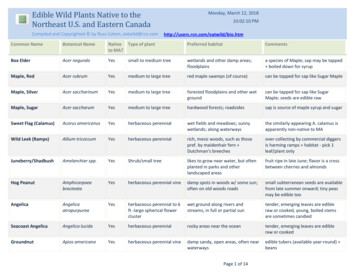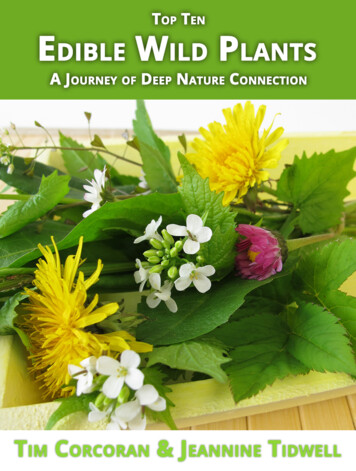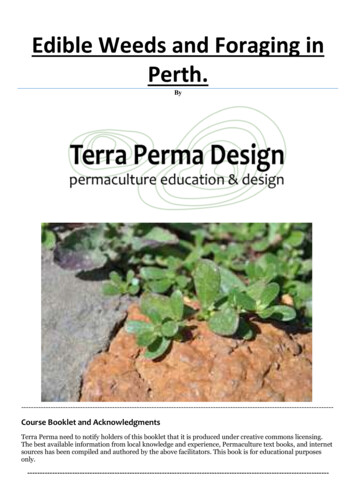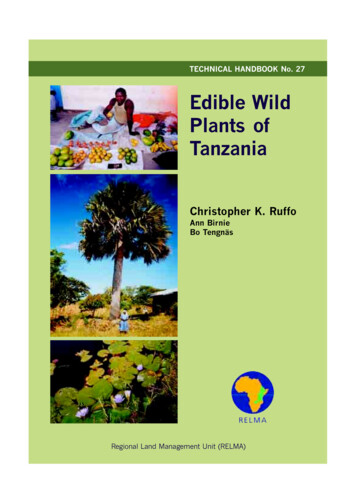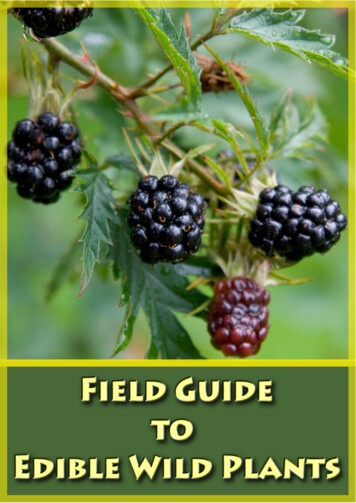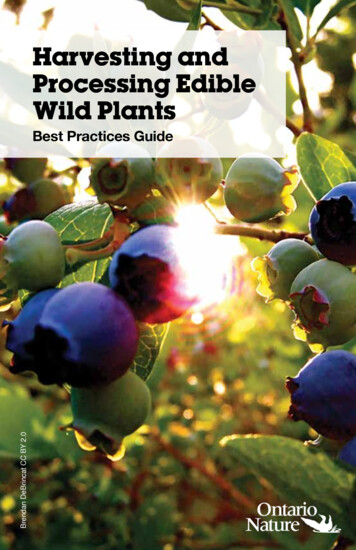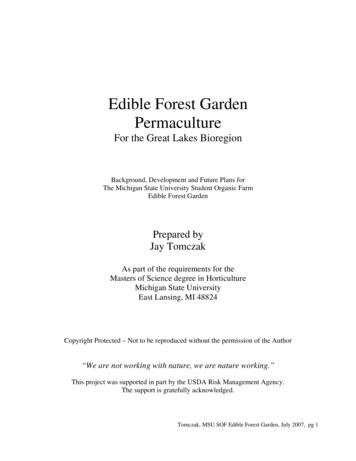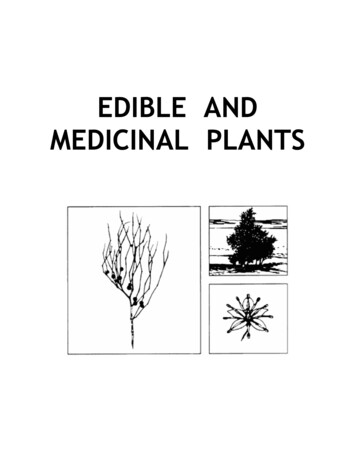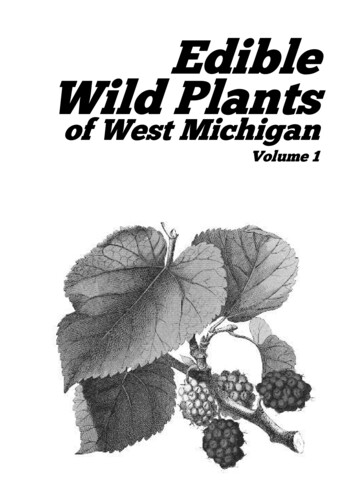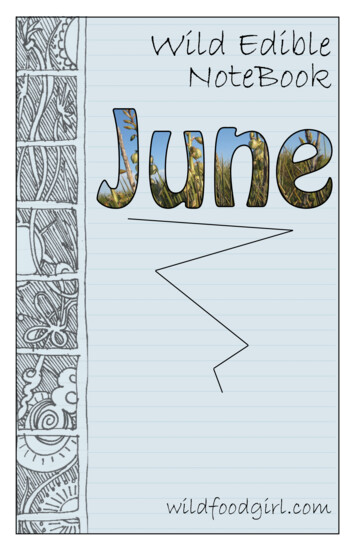
Transcription
Wild EdibleNoteBookwildfoodgirl.com
Copyright 2011 Erica T. Marciniecaka “Wild Food Girl”All rights reserved, including the right ofreproduction in whole or in part in any form.While the author has prepared this chapter to thebest of her ability, users should take necessaryprecautions including referencing multiple guidebooks prior to consuming wild plants. The stories inthis notebook may not be applicable to your locale.Consult with a professional when appropriate.The author shall not be held accountable forwhat you choose to consume.For more information,please visit:wildfoodg rl.com
June 17We Gorged Ourselves on GoosefootGoosefoot, aka lamb’squarters, wild spinach, andpigweed, is said to be one of themost popular among wild edibleplants, particularly when it comesto the uninitiate.As “Wildman” Steve Brill andEvelyn Dean put it: “If you beginlearning wild foods with only a fewplants this widely distributed, easyto-identify, tasty, nutritious, long-inseason plant should be one of thefirst on your list.”I don’t always tend to do thingsin the right order, so as it turns out,goosefoot ended up being moreLambs quarters, aka goosefoot, coming up underlike #50 on my list. But boy, what athe rose bush in Steve’s back yard.#50 it was!The opportunity to try it for the first time came about last week when Greggand I visited his brother-in-law in Fort Collins, Colorado for an early birthdaycelebration. Steve was out back mowing the lawn for a much-hoped-forbadminton tournament when we arrived. I quickly surveyed the small, fencedin enclosure to find, much to my pleasant surprise, hundreds of lamb’s quarterplants in various stages of growth. “I thought they were pretty so I didn’t weedthem out,” commented Steve, who is charged with the lawn care. Now that’s agood man!While Gregg and Steve battled it out on the slippery badminton field in thelight rain, I foraged for goosefoot in the flower beds along the edges of hislawn, snipping the tops and individual leaves off tall plants and taking thesmall plants (8 inches in height or less) in their entirety. When the rain startedcoming down harder we went inside and I spent the better part of an hourmeticulously washing and trimming leaves and stems.“Those are going to be the cleanest lamb’s quarters ever eaten,” Stevecommented from the living room, where he and Gregg had moved on to Wii1
June 17badminton. So I go a littleoverboard sometimes. Whatcan I say?“It tastes like its relative,spinach only better,”Brill writes in Identifyingand Harvesting Edible andMedicinal Plants. “However,it shrinks by about two thirdswhen you cook it, so be sure tocollect enough.”Later that evening, when theThe leaves of some lamb’s quarters are whitish on thepork was just about done andunderside, like those pictured in this photo.the potatoes were coming offthe grill, I followed Mr. Brill’s suggestion and faithfully stuffed what I thought tobe a gargantuan quantity of lamb’s quarters into a pan. I dashed it with oliveoil, salted the leaves lightly, and cooked for a couple of minutes until the leaveswilted before adding a cup of water, covering, steaming for 7 minutes, draining,and sprinkling with soy sauce. What started out as about 8 cups of plant partscooked down to about 2 cups. You do the math.The goosefoot turned out to be a big hit with the boys. “Do you mind?” Steveasked me at dinner, looking a little sheepish, as he went for a second servingbefore he had even finished the first. “I think I like it better than spinach–and Ilove spinach.”“I think this might be the best wild edible plant we’ve had yet,” Greggannounced at the end of dinner, pushing his cleaned plate away and pattinghis belly with satisfaction.Antiquated Nutritient ComparisonIn Common Edible and Medicinal Plants of Colorado, the Marchs cite U.S.Agricultural Handbook #8 (the closest reference I could find to this after a briefsearch was Handbook #8-1, published in 1979) in their comparison of thenutrients in “goosefoot” with selected commercial vegetables: 2Protein in goosefoot: 19.1 grams protein/lbProtein in spinach: 13.4 grams protein/lbVitamin A in goosefoot: 52,620 international units (?)/lbVitamin A in spinach: 33,800 international units/lb
June 17Obviously this data should be taken with a grain of salt for several reasons.First, the numbers are from a study that seems to have been published in 1979.Second, ”goosefoot” is a common name and could refer to any number ofedible Chenopodium species. Third, a USDA study showed that the nutritionalquality of 43 commercial vegetables has declined significantly since 1950 (seeIn Defense of Food by Michael Pollan), meaning that the nutritional quality ofgoosefoot might now be even greater than the veggies listed. But I include thestats to show only that goosefoot might be very good for you, indeed.Edible Species of Goosefoot and a Wee Bit of ConfusionOver Common NamesOf the edible species of Chenopodium, Samuel Thayer states in TheForager’s Harvest: A Guide to Identifying, Harvesting, and Preparing EdibleWild Plants that C. album is the most abundant, and also the one to which themonikers “lamb’s quarter” and “goosefoot” are applied. Later, however, hemakes a distinction between the two common names when he explains thatthe also-edible eastern variety, C. hybridium or C. simplex, aka “maple-leavedgoosefoot,” has larger, darker leaves than lamb’s quarters. This confused me,as I have always seen the same common names used interchangeably–whichis why, in the end, scientific names are superior to common names. For thepurpose of this entry,however, I will refer toall of the similar, edibleChenopodiums by anyand all of the abovecommon names.Aside from C. album andC. hybridium, Thayer listssome of the other ediblevarieties of Chenopodium:C. capitatum (Rockies andparts north) C. fremontii(west), and C. berlandieri,among others. (For moreinformation, pick up aLamb’s quarters cooks down a lot, so be sure to gather a largecopy of The Forager’squantity if you hope to eat it as a dish unto itself.Harvest. )3
June 17In Best-Tasting Wild Plants of Colorado and the Rockies, Cattail Bob Seebeckdescribes the leaves of three edible species of Chenopodium as “goose-footshaped” (go figure) with “lighter coloration on new growth at the tip,” andoften with red stripes on the stem. Some varieties have a whitish powder onthe underside of the leaf. (Aside from that, please refer to the pictures and yourplant guides for positive identification). Bob advises staying away from “ranksmelling or bad-tasting Chenopodium members,” as not every plant in thegenus is edible. Personally, I don’t like eating smelly or gross things, so it seemslike a good rule of thumb to me.The wild edible plants experts have a few cautionary notes when it comes tograzing on goosefoot. Even with edible varieties, Cattail Bob warns that “likespinach, eating large quantities of lambs quarter may produce mild oxalate/nitrate poisoning.” Brill explains that lamb’s quarters can absorb nitrates fromcontaminated soil and make you sick, so it’s best to be careful where youforage. Thayer points out that if you are one of those people who experiencemild irritation on the tongue with spinach (as he does), then the same will mostlikely be the case with lamb’s quarters, so you might just want to add it to a stirfry instead of eating a full dish by its lonesome.As far as Gregg, Steve, and I are concerned, not one of us was noticeablypoisoned, got sick, or even experienced irritated tongues. We did all share afunny sensation on our teeth afterwards, described by Steve as “sticky” andby Gregg as “very clean.” I would use the word “squeaky” myself. Steve saysthat spinach does the same thing to his teeth.Goosefoot EatersYears ago, as an archaeology student at Bard College in upstate New York,I learned that Native American people ate goosefoot in the Northeast forthousands of years, as evidenced by carbon-dated, charred plant remains.Later, I read in more than one wild edible plants guide that European settlerswere responsible for introducing goosefoot to North America. As you canimagine, this caused me some amount of cognitive dissonance.And then, thankfully, I picked up Samuel Thayer’s book, in which hedebunks the introduced-species-argument as it pertains to Chenopodium usingarcheological evidence, concluding colorfully: “Apparently, like stinging nettle,black nightshade, human beings, and other cosmopolitan weeds, this specieswas indeed brought from Europe, but to a continent that already had its ownindigenous strain.” I can’t tell you how much better I feel now.4
June 17Not To BeConfused withGoose FeetLast year when I wasfirst getting back intothis whole wild edibleplants thing, I found arecipe for “Noodle andGoosefoot Casserole”in Common Edible andMedicinal Plants ofColorado. “That soundsawful,” Gregg replied tomy eager prattle, not yetconvinced on the wholeYoung goosefoots (pluralizing to goosefeet just didn't seem towild food thing, themake sense) can be be eaten leaves, stems and all.thought of actual goosefeet baked in of copiousamounts of cheese no doubt etching a painful image into his mind.As I said before, Gregg has since been fully converted, but it does tickle thefunny bone to picture the scene in retrospect. And that, in turn, makes me tothink about which of my unwitting friends plans to visit next because goosefootcasserole does sound like an entertaining choice of meals to serve should theoccasion present itself. 5
6
June 24Roadside Cow Parsnip Boiled in Tap Water!The other day I wroteabout fireweed, thewild edible plant thatGregory Tilford choseto honor by adorningthe front cover of hisbook with it. Earning asimilar distinction onthe cover of Kathryn G.and Andrew L. March’s1979 guide, CommonEdible and MedicinalPlants of Coloradowith Recipes andPrescriptions, is cowUnfurling cow parsnip leaves are a wild, woolly delicacy.parsnip, a plant thatshares its classification in the Umbelliferae family with regular parsnip, carrots,parsley, dill, coriander, fennel, and anise.“The fresh young shoots and the first leaves, just as they are unfolding, area most exotic, wild and woolly, stimulating taste, a bold stroke to mark off themid-spring and early summer season,” the Marchs write. “The flavor is one ofa kind, with at most distant echoes of fresh coriander, strange at first but onecomes to crave it.”After reading that, I had to have some.There was only one catch. The Umbilliferae family comes with strongwarnings from the wild foods literature on account of some extremely toxicfamily members, including poison hemlock (Conium maculatum) and waterhemlocks (Cicuta genus) which also sport the large white umbrella-shapedumbels of tiny flowers for which the family is named. Unlike its poisonouscousins, cow parsnip (Heracleum maximum) has big, maple-leaf-shaped leaves.Similar to them, however, the mature plant features a tall stalk with big flowerheads that look something like Queen Anne’s Lace.The poison-risk-factor is why finding the new shoots and leaves of cowparsnip ended up becoming a two year process for Gregg and me. Last7
June 24summer we identified themature plants, makingabsolutely certain of ouridentification with theaid of numerous guidebooks. We rememberedwhere the plants werelocated and returnedthis year to find theyoung shoots and leaves,often alongside the tall,dry stalks of last year’sflowers.We tasted our first cowparsnip a few days agofollowing a recipe in theMarchs’ book that callsfor boiling the plant partsfor 10 minutes, changingthe water, boiling foranother ten minutes, andthen adding soy sauce,butter, and choppedMature roadside cow parsnip, summer 2009onions.It was a unique taste, to say the least. I don’t know what fresh coriandertastes like, but cow parsnip tastes like nothing I’ve ever tasted before. Greggopined that the raw onions were key to the recipe. I swear I’ve never seen thisin the two years that we’ve known each other, but Gregg—the supposed onionhater–got up and helped himself to a second serving of raw onions.All in all, the cow parsnip was good. Weird, but good.Finding the Cow ParsnipToday, after meeting with my bank-provided financial advisor on how onearth I am going to make a proper living as a freelance writer/snowboardbum, I stopped by a less-than-wild roadside spot where we had seen maturecow parsnip the year before.Sure enough, I spotted the big maple-shaped leaves out the passengerwindow, so I pulled into a convenient nook and parked the car. There was not8
June 24a soul in sight and I headed down the steep embankment to snip a coupleof small, fuzzy leaves and stems, filling a small bag after 15 minutes. I haveto admit that the spot might have been a bit too close to the road for comfort(roads pollution on your plants) if it weren’t for the fact that it seemed so littletrodden. Afterwards I climbed back up, took my wild booty to the car, anddrove up the street for round two of the adventure.My plan was to explore a swollen spring stream in a section of national forest,since a recent call to the ranger station revealed that I can sustainably foragesmall amounts of plants for personal use in the Pike and San Isabel NationalForests. I parked the car, grabbed my scissors and bags, and followed thestream up on its darker, forested side, thinking all the while that the tangledmass of willows and undergrowth on the other side might be a better spot forcow parsnip. When the opportunity presented itself, I crossed and pushed myway into the underbrushon the other side.Sure enough, it was averitable jackpot of cowparsnip!According toknowledge gleanedfrom the Marchs’ book,the foraging of cowparsnip involves takingsmall, fuzzy, leaves—both those which arenot quite unfurlingand those which arejust starting to unfurl,succulent stems and all.I stuck to the Marchs’suggestion to harvest“plants no higher than6 inches,” staying onthe willowy side of thestream while followingit back roughly in thedirection from which I’dcome.Young cow parsnip leaves, unfurling.9
June 24Young cow parsnip, aka Heracleum maximum, by the stream.You have to keep an eye out for it, but once you start to recognize the big,maple-shaped leaves, cow parsnip is fairly easy to spot. The yummy newgrowth is underneath the big leaves. When you cut a stem, there is a distinctive“wild” and “woolly” aroma. Also, heed this word of caution from “Wildman”Steve Brill and Evelyn Dean (1994): “Touching the plant in conjunction withsunlight and wet, sweaty skin may give sensitive people rashes.”The tangled side of the stream ended up being a trail of cow parsnip fromstart to finish. Even though I only harvested new leaves, one or two per plant, Iwas still able to get a healthy serving for two. Unfortunately, just as should havebeen arriving at the car, I came upon a house in the middle of the forest. Yikes!I doubled back quickly, afraid I had strayed onto private land.That’s when I spied a jaunty older couple coming down a path fromsomewhere up above–she with a walking stick, and he carrying a good-sizedrock. “Oh, do you know if we’re on public land?” I asked, surprised to seethem there. Well, my false alarm led to another discovery—an old miningroad that doubles as a popular hiking trail. Tee hee. So I walked with the nicecouple past the house that had startled me. I showed them cow parsnip andthey told me they were on vacation from Minnesota. How nice!10
June 24Cooking the Cow ParsnipOur tap water at home–which is usually clean and clear–is now silty. I don’tknow if we used too much water or our neighbors used too much water, butwe’ve changed the filter once already and the water is still a light gray mudcolor. When I got home, Gregg was already on his way down to Boulder andthen Longmont to hash up web design plans and teach kids to skateboard,respectively. So I was on my own for lunch, and veggie burgers with a side ofcow parsnip sounded perfect. I decided to start with the “roadside” batch andsave the more pristine forest parsnip for Gregg to try. Here’s what I did:1. Set a pot of silty tap water to boil.2. Clean sink and fill with enough siltwater to cover roadside cow parsnip.3. Wash plant parts thoroughly to remove dust and road chemicals (very, verywell, in other words).4. Boil in silty tap water for 10 minutes and strain.5. Cover with more siltwater and bring to a boil, then remove from heat andstrain.It may sound nasty because that’s kind of how I felt about it—until I tastedit, that is. That roadside cow parsnip turned out to be quite the delicacy. Afterstraining it, I removed the soggy goodness with tongs on account of its extremetenderness. Then I sprinkled a generous portion of chopped Vidalia onionsand smaller amounts of soy sauce and butter (Smart Balance imitation butter,actually) on top and worked the ingredients gently into the mushy mass.Ah. I very much echo the Marchs’ sentiment about the wonderful, wild, andwoolly flavor of new cow parsnip leaves. It was absolutely amazing and Isavored every minute of it.The Marchs’ book is now out of print and expensive despite the fact that itis but a humble two-color piece with so delicate a binding that the pages fallout all the time. Still, I think those two were onto something. The cow parsnip isdelicious, enhanced all the more by their flavorful, exotic descriptions. 11
12
June 26Yucca in My Pantry AgainMy pantry is stocked with yucca flowers again, thanks to one intrepidboyfriend who took it upon himself to harvest it on his way back to themountains from Denver. We often try to pick yucca up on our way back fromparts lower, seeing as it doesn’t grow up here near the house above 11,000feet. But usually theyucca-gathering is not asolo mission–so Greggdeserves much thanks forcoming home with somemore of the sweet, fleshyflowers that I like to servewith eggs, in stir fries andsoups, or fresh on salads.Know the RegsOne of the difficultieswe’ve encountered inforaging for wild foodis what can seem like alack of available groundson which to do so. Signsannouncing hefty finesfor the removal of floraand fauna are commonat the entrances to manypublic parks and land.(It is important, therefore,Blooming yucca flowers, ripe for harvest.to keep an eye out forposted regulations and make sure to only forage where it is permitted).Depending on where you live, you might be fortunate enough to haveaccess to a national or state park that allows you to forage freely forpersonal use or to buy a foraging permit. Some parks permit the removalof invasive or unwanted weeds, for example, but definitely no endangered13
June 26species. It’s worth looking into rulesand regulations if you plan to foragefor wild plants in your area, since theyvary even among different jurisdictionsof the U.S. Forest Service. The localranger station is a good place tostart; you can find out any regulationson protected plants and harvestingmethods (no root vegetables, forexample) while you’re at it.For the recreational forager towhom access to public land is limited,however, the only other option isprivately-owned land. But who has thatmuch private land? Certainly not I. Theright thing to do in this case is to finda friend or two with land (that has notbeen chemically treated) who will letyou forage on his or her property. Thisis the ideal scenario.A field of yucca in the Denver suburbs,suburban landscape in the distance.Guerrilla ForagingNow, as for me, I would be lying if I said that I never took advantage of anopportunity to forage discreetly on land I did not own. I have, in fact, devised atechnique for it.First, I scope out the wild edibles in a given landscape from the passengerseat of a car. You’d be surprised how much you can identify at 35 to 60 mphonce you’ve a trained eye for it–tall spires of bulbous white yucca flowers,big pale green rosettes of furry mullein leaves next to the tall, dried stalks oflast year’s plants, and so forth. Then I consider factors such as who owns theland and whether or not I feel it is necessary to ask his or her permission tosustainably harvest, say, a handful of dandelion greens or a few mullein leaveshere and there.On a recent trip to the Denver suburbs, then, after staring hungrily outthe passenger window at field after field of juicy yucca flowers ripe for thepicking, I found what I was looking for–a large, open field, uncrossed bypollution-generating roads, and literally covered with yucca. Upon closer14
June 26inspection, Gregg andI observed that not onlywas the field surroundedby cookie-cutter housingdevelopments, but thatformer cattle-grazinggrounds in questionwere slated for similarconstruction in the not-sodistant future.Is it fair to justifytrespassing based on one’sown abhorrence of theurban sprawl that gatedcommunities constitute?Perhaps not. But one thingI know for certain is this:The bugs like yucca too, so watch out for creepy crawliesIt is common practice forwhen you’re foraging for yucca flowers.builders to completelyraze any and all vegetation on a development site prior to constructing saidhousing, and to later re-plant the land with lush, chemically-treated dandelionfree lawns and picture-perfect landscaping.So that was my justification. We drove around until we found an obscureplace to park and then disappeared up over the hill with our scissors and bags.Yucca Bugs, Yucka!The yucca was plentiful, although the bugs had gotten to some of it already.In the Lone Pine Field Guide to Plants of the Rocky Mountains, Kershaw et. al.(1998) talk about a yucca moth that lives symbiotically with yucca, pollinatingthe flowers as she flies from plant to plant, boring into the ovaries to lay hereggs. “Ripe yucca pods almost always have a tiny hole, where the grub ate itsway out,” the guide states. That’s great for the yucca and all–but yucka!So we steered clear of any bug-infested yuccas and were fortunate to finda number of seemingly bug-free plants. We harvested only a few flowers fromeach one, despite their impending doom, in the hopes that the next time wevisit there will still be yuccas, perhaps by then sporting the green fruits withwhich I experimented initially last year.15
June 26On such occasions I always have a hard time keeping myself from lookingover my shoulder repeatedly, worried that I’m doing something wrong. I founda similar sentiment, although in a very different context, in a recap of a study ofHmong people foraging on public and private lands near St. Paul, Minnesota.As Simple Good and Tasty blog writer Rhena Tantisunthorn explains, “theHmong face intimidation by land owners who will use tactics such as sendingout their dogs to scare the foragers away.” According to David Bengston of theUSDA Forest Service, a Hmong person is quoted as saying, “Gathering wasa way of life back home. But here it’s like stealing,” (qtd. in Tantisunthorn).As a result, someHmong now referto wild edibleplants as “timid”or “embarrassed”vegetables.“No one is coming,”Gregg asserts tome repeatedlyupon witnessing myparanoid foraging,”and it isn’t eventrespassing.”Personally, I don’tsee how he canreach that conclusionafter we pass a “NoA pretty yucca flower fried in butter.Trespassing” sign infront of a differententrance to the same field. Timid vegetables, indeed.Sweet Yucca Flower PetalsWhen you fry or boil yucca flower petals, they turn light green, causing meto sometimes refer to them as ”leaves” by accident, to which Gregg alwaysreplies, “I don’t want to eat yucca leaves; they’re sharp and pointy.” Whichbrings up an important point of caution when it comes to harvesting yucca: Inaddition to the bug thing and the possible consequences of trespassing, watchout not to get poked by the leaves–as they will most certainly draw blood. The16
June 26flower petals areyummy, sweetish andsucculent. They makea good addition tostir fries and soups,not to mention anattractive garnish. Ialso like to fry themup in olive oil, withwild greens or alone,salt lightly, and serveas a side dish.In Edible Flowers:From Gardento Palate, CathyTantalizing ingredients of spring.Wilkinson Barashsays that when eatingflowers, one should remove the pistils and stamens and only eat the flowerpetals, although I have yet to discover exactly why. I tend to eat the yucca petalsseparately from the thick pistils myself, but I do eat the pistils and stamens, usuallyboiled in soups or cut up and fried sufficiently. (Readers should keep in mindthat there may be some variation in the edibility of different species of yucca indifferent areas of the country, so it is always good to cross reference with multipleguides and to test a small amount first before eating an entire plant by oneself. )Wildlife in My Yucca FlowersWe finished our ill-gotten Denver yucca pretty quickly, which is why Greggunderwent a subsequent mission near Bailey, Colorado, for this latest batch.It was getting late when he got there, however, and because of the fadinglight he was unable to distinguish the bugginess of the flowers he snipped. Asa result, I found myself washing a few tiny egg nests and little aphid lookingbabies (I presume) along with their mothers out of some of the flowers, wherethey were hunkered down near the base of the pistils. (Animal rights people,please don’t hate me.) And may this be a lesson to all of you as to why you justdon’t harvest yucca at night. 17
Wild Plants that C. album is the most abundant, and also the one to which the monikers “lamb’s quarter” and “goosefoot” are applied. Later, however, he makes a distinction between the two common names when he explains that the also-edible easte
